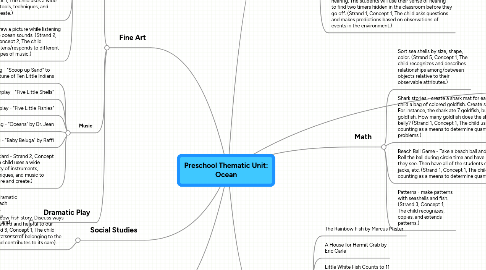Preschool Thematic Unit: Ocean
создатель Traci Neyland

1. Fine Art
1.1. Art
1.1.1. Make sand castles. Mix 1 cup cornstarch, 2 cups fine sand, 1.5 cups cold water. Stir 5-10 minutes over medium heat until thick. Cool and store in a plastic bag. Give children some sand dough on a paper plate along with small shells, pebbles, and straws to decorate their castles. (Strand 1, Concept 1, The child uses a wide variety of materials, media, tools, techniques, and processes to explore and create.)
1.1.2. Rainbow Fish - after reading the story the rainbow fish, give each child one piece of aluminum foil to decorate their fish. Use a construction paper and wax paper to make the fish. Give students pieces of tissue paper to decorate the fish. Hang in the window. (Strand 1, Concept 1, The child uses a wide variety of materials, media, tools, techniques, and processes to explore and create.)
1.1.3. Star Fish - give each child a bag of cereal (Cherrios). Have them mash the bag. Give them a starfish shape and glue. Children can decorate the starfish with the crunched cereal. (Strand 1, Concept 1, The child uses a wide variety of materials, media, tools, techniques, and processes to explore and create.)
1.1.4. Make a beach scene with baby food jars, sand, pebbles and shells (Strand 1, Concept 1, The child uses a wide variety of materials, media, tools, techniques, and processes to explore and create.)
1.1.5. Draw a picture while listening to ocean sounds. (Strand 2, Concept 2, The child listens/responds to different types of music.)
1.2. Music
1.2.1. Song - "Scoop up Sand" to the tune of Ten Little Indians
1.2.2. Fingerplay - "Five Little Shells"
1.2.3. Fingerplay - "Five Little Fishies"
1.2.4. Song - "Oceans" by Dr. Jean
1.2.5. Song - "Baby Beluga" by Raffi
1.2.6. Standard - Strand 2, Concept 1, The child uses a wide variety of instruments, techniques, and music to explore and create.)
1.3. Dramatic Play
1.3.1. Beach props will be added to the dramatic play area including: sunglasses, beach towels, sun hats, and sand buckets. (Strand 3, Concept 1, The child uses dramatic play and props to explore and create.)
2. Social Studies
2.1. Read the Rainbow Fish story. Discuss ways that we can be kind and helpful to our friends. (Strand 3, Concept 1, The child demonstrates a sense of belonging to the community and contributes to its care).
3. Physical Movement
3.1. Gross Motor
3.1.1. The children will hold hands and make wave like motions with their arms. (Strand 1, Concept 2, The child demonstrates coordination of body movements.)
3.1.2. Walk like a crab; walk like a crab and carry a bean bag. (Strand 1, Concept 2, The child demonstrates coordination of body movements.)
3.2. Fine Motor
3.2.1. Make seashell prints in playdough. (Strand 1, Concept 3, The child uses fingers and hands to manipulate tools and materials.)
4. Science
4.1. Observe a live hermit crab. (Strand 1, Concept 4, The child describes, discusses or or presents predictions, explanations and generalizations.)
4.2. Conduct an experiment noting the differences between salt water and regular water. Use a bucket of salt water and a bucket of regular water. Place a potato in one and then in the other. (Strand 1, Concept 3, The child forms conclusions about his/her observations and experimentations.)
4.3. Explore wave bottles. (Use plastic bottles and fill up with blue tinted water, oil, and some plastice fish). The children can shake the bottles to form waves. They can also see the separation of the water and oil. (Strand 1, Concept 4, The child describes, discusses or or presents predictions, explanations and generalizations.)
4.4. Snorkeling - tape pictures of ocean animals underneath a table. Place a blanket over the table. Allow a few children at a time to take some snorkels underneath the table. When they are done, ask them to describe what they saw. (Strand 1, Concept 4, The child describes, discusses or or presents predictions, explanations and generalizations.)
4.5. Shark Hunt - sharks have an excellent sense of hearing. The students will use their sense of hearing to find two timers hidden in the classroom before they go off. (Strand 1, Concept 1, The child asks questions and makes predictions based on observations of events in the environment.)
5. Literature
5.1. The Rainbow Fish by Marcus Pfister
5.2. A House for Hermit Crab by Eric Carle
5.3. Little White Fish Counts to 11 by Guido Van Genechten
5.4. The Three Little Fish and the Big Bad Shark by Ken Geist and Julia Gorton
5.5. I'm the Biggest Thing in the Ocean by Kevin Sherry
5.6. Standard: Concept 1, Strand 1, The child listens to directions, stories and conversations
6. Math
6.1. Sort sea shells by size, shape, color. (Strand 5, Concept 1, The child recognizes and describes relationships among/between objects relative to their observable attributes.)
6.2. Shark stories - create a shark mat for each child and give each child a bag of colored goldfish. Create stories with the goldfish. For instance, the shark ate 7 goldfish, but then threwup 2 goldfish. How many goldfish does the shark now have in his belly? (Strand 1, Concept 1, The child uses numbers and counting as a means to determine quantity and solve problems.)
6.3. Beach Ball Game - Take a beach ball and write the numbers 1-10. Roll the ball during circle time and have the child read the number they see. Then have all of the students do that many jumping jacks, etc. (Strand 1, Concept 1, The child uses numbers and counting as a means to determine quantity and solve problems.)
6.4. Patterns - make patterns with seashells and fish. (Strand 3, Concept 1, The child recognizes, copies, and extends patterns.)
7. New node

